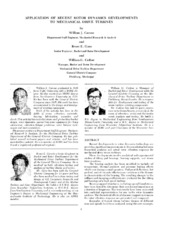| dc.description.abstract | Recent developments in rotor dynamics technology are providing significant improvements in the correlation between theoretical analyses and actual rotor vibration response for mechanical drive steam turbines. These developments involve analytical and experimental studies of tilting pad bearings, bearing supports, and steam force reactions. The bearing analysis has been modified to include oil temperature, thermal gradient, and pressure loading effects which exist during normal operation. Pad pivot deflections, hot preload, and oil viscosity effects cause variations in the dynamic characteristics of the bearing. The resulting changes in the stiffness and damping coefficients are evaluated for the tilting pad bearings of a high speed turbine. Bearing support structures, including special foundations, have been tested to determine their mechanical impedance as a function of frequency. The test results have been converted into analytical representations for use in the rotor dynamics analyses. The theoretical effects of dynamic support systems on the rotor vibration response are presented and compared. Examples of typical steam turbine designs of different sizes and speeds have been analyzed, using the new concepts. In each case, special response tests were conducted in which unbalance weights were installed in the rotor and the resultant changes in orbital vibration vectors were determined. The correlations between calculated and actual shaft amplitudes are shown for each case. Bearing reactions are affected by directional steam forces which exist during turbine operation with partial arc steam admission. Recent analyses show the interaction of gravity and steam force vectors causing changes in the bearing oil film characteristics. This condition will not be evident in a routine no-load factory test, but may produce significant changes in rotor vibration for a turbine in service. Some field observations for turbines operating with load are presented to substantiate the analysis. | en |


